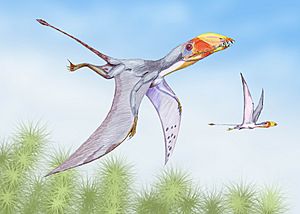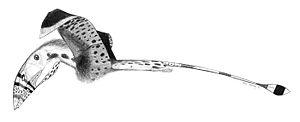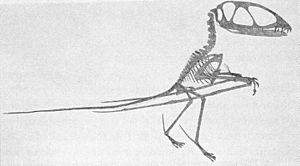Dimorphodon facts for kids
Quick facts for kids DimorphodonTemporal range: Lower Jurassic
|
|
|---|---|
 |
|
| Conservation status | |
|
Fossil
|
|
| Scientific classification | |
| Kingdom: | |
| Phylum: | |
| Class: | |
| Order: | |
| Suborder: | |
| Family: |
Dimorphodontidae
|
| Genus: |
Dimorphodon
Owen, 1859
|
| Species | |
|
|
Dimorphodon was a flying pterosaur that lived a very long time ago. It was around during the early Jurassic period. This ancient creature had a large head and a tall beak. What made it special was having two different kinds of teeth. This was quite unusual for a pterosaur!
Like another pterosaur called Rhamphorhynchus, Dimorphodon fossils are only found in rocks from the Jurassic period. The first Dimorphodon was discovered in England in 1828. It was found by a famous fossil hunter named Mary Anning.
Contents
What Did Dimorphodon Look Like?
Dimorphodon had some features that scientists call "primitive." This means they were like older, less evolved animals. For example, it had a very small brain and wings that were not very long. The first bone in its flight finger was only a little longer than its lower arm.
Its neck was short but strong and could bend easily. It might have had a pouch under its neck, like some modern birds. The bones in its spine were hollow, allowing air sacs to reach inside. This made its skeleton lighter.
An adult Dimorphodon was about 1 meter (3.3 feet) long. Its wings could stretch out to about 1.45 meters (4.6 feet) wide. Its tail was long, with thirty bones. The first few tail bones were short and flexible. The rest became longer and were stiffened by special bony rods. Scientists think the end of its tail might have had a vane, like a rudder, similar to Rhamphorhynchus. However, no fossil evidence has confirmed this yet.
Its Unique Skull and Teeth
Dimorphodon had a big, strong skull, about 23 centimeters (9 inches) long. Its skull was light because it had large openings separated by thin bones. This design was like a bridge, making it strong but not heavy.
The front of its upper jaw had four or five sharp, fang-like teeth. Behind these, it had many smaller teeth. The lower jaw had five longer teeth at the front. Then, it had about thirty to forty tiny, flat, pointed teeth. These looked a bit like small knives. Some drawings show Dimorphodon with a beak like a puffin. This is because their skulls have some similar features.
How Dimorphodon Lived
What Did Dimorphodon Eat?
We don't know everything about how Dimorphodon lived. It probably lived near the coast. It might have eaten many different things. At first, some scientists thought it ate insects. Later, many believed it ate fish.
However, newer studies suggest that eating insects was more likely. Its jaws were built to snap shut very quickly. But they didn't have much biting force. This, along with its short, high skull and pointed front teeth, suggests it was an insectivore. This means it mostly ate insects. It might have also eaten small animals or dead creatures sometimes.
Some scientists, like Mark Witton, think it was too big to only eat insects. They believe it was a specialized meat-eater. It might have hunted small lizards, other reptiles, and mammals. But because its jaws were not very strong, it probably ate smaller prey.
How Dimorphodon Moved Around
In the past, many thought Dimorphodon was a great flyer, like a seabird. But recent studies show it was not a very good flyer. Its wings were short compared to its body. Its bones were also quite heavy. This meant it couldn't glide very well.
Dimorphodon probably flew in short, quick bursts. This is similar to how modern fowl, tinamous, and woodpeckers fly. It likely only took to the air when it really had to.
It's interesting that Dimorphodon was a poor flyer. This is because earlier pterosaurs, like Preondactylus, were good at flying. This suggests that Dimorphodon developed its less efficient flight over time.
Some scientists thought Dimorphodon walked on four legs. Others, like Harry Seeley, believed it was active and warm-blooded. He thought it could walk on all fours or even run on two legs. This was because its back legs were quite strong.
However, fossil footprints from other pterosaurs show they walked on four legs. Dimorphodon had a long, clawless fifth toe that pointed sideways. Because of this, many scientists now agree that Dimorphodon walked on all four legs. Computer models also support this idea.
Like most early pterosaurs, Dimorphodon was good at climbing. It had large, curved claws and a low center of gravity. It probably climbed trees by hopping, much like modern squirrels do.
Images for kids
See also
 In Spanish: Dimorphodon para niños
In Spanish: Dimorphodon para niños










